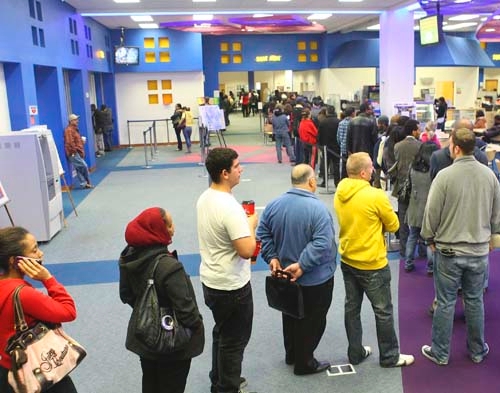Students line up as CSN classes open up
There was this guy at the College of Southern Nevada, 7:30 a.m. Tuesday, in the front of a line inside the D building. He stood behind a gate that closed off a dark room.
This guy, Juan Gonzalez, 20, had been in that line for 5½ hours, since 2 a.m. Still had a half hour to go before the gate would open. Behind him, the line snaked past the cashier, the disability resources desk, the testing center, down the hall, past the bathrooms, around the corner, down another hall, around another corner so it almost looped back in on itself, past the international center, by the information desk, the front door, the elevator, the snack bar, express counseling, and stopped at the vending machines just shy of the exit.
Gonzalez looked tired. Puffy eyes, kind of a mumbling demeanor, big jacket hunched around him.
He's studying to be a nurse. Maybe an anesthesiologist. But there's an obstacle. CSN is full. Everything, full. He tried registering earlier, as soon as he was allowed. Three nursing classes he needs, full. A clinical, a lab, a lecture.
"It kinda sucks because without one, there's no point in taking the others," he said.
Nursing is one of those programs where you can't take class two until you've finished class one, where you can't take a lecture without taking the lab. But there's no room.
Last week, students who had registered for classes but hadn't paid yet were kicked out. That's called purge day. It meant there were a few openings here and there in some classes.
Most students who wanted to get in did it online, starting Tuesday morning. But school officials said the computer system sometimes gets overloaded on the first day students can register after purge day.
So, if you're desperate, you go wait in line like Gonzalez and the 300 people behind him.
Michael Richards, the school president, said the computer and phone lines were so booked Tuesday, he was using his cell phone to call outside the building.
Even by late afternoon, there were still more than 100 people in line, trying to get into classes.
The numbers aren't in for this semester yet -- classes don't start until next week -- but officials say there were 5,294 students who tried registering for a class last semester, couldn't get in because it was full, and so went away without going to college.
Richards said CSN's classes averaged 80 percent full in 2006. In the fall, they averaged 94 percent full.
To help, the school has added late night classes, increased the minimum number of students needed to make a class official, and added more online classes. Professors are required to teach five classes per semester, Richards said.
"We're just using every possible resource that we can use. Crimping the edges, looking for every efficiency we can find, but we still can't meet demand," he said.
Like this other guy in line Tuesday.
James Montgomery, 41, had just gotten off work. He's a bartender. Used to be a search and rescue swimmer in the Navy. He served in Desert Storm. He's studying to become a social worker. He wants to work with disabled veterans.
He's attending CSN with Veteran's Administration money, so he has to be a full-time student, meaning at least four classes per semester.
But two of the classes he needs were full when he tried to register. So there he was on Tuesday, at the back of that long, snaking line.
If he couldn't get the math and English classes he needed, he said, he'd sign up for something. Aerobics. Whatever. It would mean it would take him longer to get that associate's degree, longer to get his bachelor's degree from the University of Nevada, Las Vegas, longer to become a college-educated member of the work force.
All of this probably will get worse.
CSN is the largest higher education institution in the state, with nearly 44,000 students enrolled last semester. Its enrollment is almost as large as UNLV's and the University of Nevada, Reno's combined, and it's been growing like crazy for three decades.
But the state is out of money. Budgets have been cut in recent years. More cuts are expected. Nobody knows how much, but estimates are that the higher education system could see a 20 percent drop in state support.
There are no easy solutions. Higher education leaders say they'll probably have to do something drastic, maybe more than one thing: layoffs, department eliminations, enrollment caps.
Said Richards, "5,294 last fall walked away from us because they couldn't get into class; 58 percent of them were minorities. At some point, the state has to decide we're worthy of an investment."
If money was available, he said, they'd build more classrooms. They'd hire more teachers. There would be more classes for students to take. More students would graduate. More graduates would enter the work force. They'd make more money. Pay higher taxes.
But there isn't any money.
"What that means is we turn away more students," Richards said. "It might be 5,294 again. It might be 8,294. It might be 10,000 students turned away because we didn't have room for them."
Contact reporter Richard Lake at rlake@review
journal.com or 702-383-0307.






















